The Effect of Process Parameters on the Microstructure, Stability, and Sensorial Properties of an Emulsion Cream Formulation
Abstract
:1. Introduction
2. Materials and Methods
2.1. Materials
2.2. Emulsion Cream Preparation
- Step 1.
- Charge purified water and PEG 400 into the main vessel, and heat to 60 ± 5 °C and mix at 90 rpm for 10 min.
- Step 2.
- Charge light mineral oil, white petrolatum, emulsifying wax, and oleyl alcohol in an appropriately sized jacketed vessel. Heat the content to 60 ± 5 °C, and mix at 90 rpm until all materials are fully melted and uniformly mixed.
- Step 3.
- Transfer the content of the jacketed vessel into the main vessel. Homogenize at speed SA for a duration of tA, and mix at 120 rpm at 60 ± 3 °C.
- Step 4.
- Cool the content of the main vessel at 0.5 ± 0.1 °C/min while mixing at 90 rpm and homogenizing at speed SB rpm for tB minutes until the temperature reaches TB.
- Step 5.
- Dissolve lidocaine in transcutol at TB. Charge transcutol into the main vessel while mixing at 120 rpm. After the addition is completed, homogenize at speed SC rpm for tC minutes at TB.
- Step 6.
- Cool the content to 25 ± 3 °C at 0.25 ± 0.1 °C/min while mixing at 70 rpm. Once the temperature reaches 25 °C, homogenize at 2500 rpm for 5 or 10 min.
- Step 7.
- Stop mixing, and keep the product stored at 25 °C for 24 h.
- Step 6.1.
- Cool the content to temperature TE at 0.25 ± 0.1 °C/min while mixing at 70 rpm and homogenizing at 2500 rpm for 5 min.
- Step 6.2.
- Mix at 70 rpm at temperature TE for 30 min (additional shear step).
- Step 6.3.
- Hold at temperature TE for 20 h with no mixing.
- Step 6.4.
- Cool at 0.25 ± 0.1 °C/min to 25 ± 3 °C (not required if TE is set at 25 °C).
2.3. Characterization Techniques
2.3.1. Microscopy Analysis
2.3.2. Physical Stability
2.3.3. Rheological Properties
2.3.4. Sensorial Properties—Texture and Tribology Analysis
2.3.5. Thermal Analysis
2.3.6. High Performance Liquid Chromatography (HPLC) Assay of Lidocaine
2.3.7. In Vitro Release
3. Results and Discussion
3.1. Preliminary Experiments
3.2. Final Design of Experiment
3.2.1. Stability of Emulsion
3.2.2. Rheological Properties of Emulsion Cream
3.2.3. Sensorial Properties of Emulsion Cream
3.2.4. In Vitro Release of Emulsion Cream
3.2.5. Stabilization Mechanism
4. Conclusions
Supplementary Materials
Author Contributions
Funding
Institutional Review Board Statement
Informed Consent Statement
Data Availability Statement
Conflicts of Interest
References
- Badruddoza, A.Z.M.; Yeoh, T.; Shah, J.C.; Walsh, T. Assessing and Predicting Physical Stability of Emulsion-Based Topical Semisolid Products: A Review. J. Pharm. Sci. 2023, 112, 1772–1793. [Google Scholar] [CrossRef]
- Chang, R.-K.; Raw, A.; Lionberger, R.; Yu, L. Generic Development of Topical Dermatologic Products: Formulation Development, Process Development, and Testing of Topical Dermatologic Products. AAPS J. 2013, 15, 41–52. [Google Scholar] [CrossRef]
- Ethier, A.; Bansal, P.; Baxter, J.; Langley, N.; Richardson, N.; Patel, A.M. The Role of Excipients in the Microstructure of Topical Semisolid Drug Products. In The Role of Microstructure in Topical Drug Product Development; Langley, N., Michniak-Kohn, B., Osborne, D.W., Eds.; Springer International Publishing: Cham, Switzerland, 2019; pp. 155–193. [Google Scholar] [CrossRef]
- Mangas-Sanjuán, V.; Pleguezuelos-Villa, M.; Merino-Sanjuán, M.; Hernández, M.J.; Nácher, A.; García-Arieta, A.; Peris, D.; Hidalgo, I.; Soler, L.; Sallan, M.; et al. Assessment of the Inter-Batch Variability of Microstructure Parameters in Topical Semisolids and Impact on the Demonstration of Equivalence. Pharmaceutics 2019, 11, 503. [Google Scholar] [CrossRef]
- Chang, R.-K.; Raw, A.; Lionberger, R.; Yu, L. Generic Development of Topical Dermatologic Products, Part II: Quality by Design for Topical Semisolid Products. AAPS J. 2013, 15, 674–683. [Google Scholar] [CrossRef]
- Chow, P.S.; Lim, R.T.; Cyriac, F.; Shah, J.C.; Badruddoza, A.Z.; Yeoh, T.; Yagnik, C.K.; Tee, X.Y.; Wong, A.B.; Chia, V.D.; et al. Influence of Manufacturing Process on the Microstructure, Stability, and Sensorial Properties of a Topical Ointment Formulation. Pharmaceutics 2023, 15, 2219. [Google Scholar] [CrossRef]
- Namjoshi, S.; Dabbaghi, M.; Roberts, M.S.; Grice, J.E.; Mohammed, Y. Quality by Design: Development of the Quality Target Product Profile (QTPP) for Semisolid Topical Products. Pharmaceutics 2020, 12, 287. [Google Scholar] [CrossRef]
- Harris, D. Particulates in Semi-Solid Pharmaceutical Products. In Particles and Nanoparticles in Pharmaceutical Products: Design, Manufacturing, Behavior and Performance; Merkus, H.G., Meesters, G.M.H., Oostra, W., Eds.; Springer International Publishing: Cham, Switzerland, 2018; pp. 399–428. [Google Scholar] [CrossRef]
- Mahalingam, R.; Li, X.; Jasti, B.R. Semisolid Dosages: Ointments, Creams, and Gels. In Pharmaceutical Manufacturing Handbook; John Wiley & Sons: Hoboken, NJ, USA, 2008; pp. 267–312. [Google Scholar] [CrossRef]
- Adu-Gyamfi, N.; Sarker, D.K. Interfacial Effects and the Nano-Scale Disruption in Adsorbed-Layer of Acrylate Polymer-Tween 80 Fabricated Steroid-Bearing Emulsions: A Rheological Study of Supramolecular Materials. Nanomaterials 2021, 11, 1612. [Google Scholar] [CrossRef]
- McClements, D.J. Critical Review of Techniques and Methodologies for Characterization of Emulsion Stability. Crit. Rev. Food Sci. Nutr. 2007, 47, 611–649. [Google Scholar] [CrossRef]
- Ali, S.; Tiwari, A.; Yeoh, T.; Doshi, P.; Kelkar, N.; Shah, J.C.; Seth, J.R. Crystallization and Rheology of Mono- and Diglycerides and Their Role in Stabilization of Emulsion Droplets in Model Topical Ointments. Langmuir 2022, 38, 8502–8512. [Google Scholar] [CrossRef]
- Ashizuka, Y.; Otoguro, S.; Horisawa, E. Effects of Manufacturing Conditions on Pharmaceutical Properties of Petrolatum Ointment—Distribution of Hydrocarbon—. Chem. Pharm. Bull. 2021, 69, 352–359. [Google Scholar] [CrossRef]
- Binks, B.P.; Desforges, A.; Duff, D.G. Synergistic Stabilization of Emulsions by a Mixture of Surface-Active Nanoparticles and Surfactant. Langmuir 2007, 23, 1098–1106. [Google Scholar] [CrossRef]
- Kori, A.H.; Mahesar, S.A.; Sherazi, S.T.H.; Khatri, U.A.; Laghari, Z.H.; Panhwar, T. Effect of process parameters on emulsion stability and droplet size of pomegranate oil-in-water. Grasas Y Aceites 2021, 72, e410. [Google Scholar] [CrossRef]
- Wang, H.; Tan, P.; Barona, D.; Li, G.; Hoe, S.; Lechuga-Ballesteros, D.; Nobes, D.S.; Vehring, R. Characterization of the suspension stability of pharmaceuticals using a shadowgraphic imaging method. Int. J. Pharm. 2018, 548, 128–138. [Google Scholar] [CrossRef]
- Lerche, D.; Sobisch, T. Direct and Accelerated Characterization of Formulation Stability. J. Dispers. Sci. Technol. 2011, 32, 1799–1811. [Google Scholar] [CrossRef]
- Cyriac, F.; Xin Yi, T.; Chow, P.S. Influence of wall slip, thixotropy and lubrication regime on the instrumental sensory evaluation of topical formulations. Int. J. Cosmet. Sci. 2022, 44, 271–288. [Google Scholar] [CrossRef]
- Cyriac, F.; Xin Yi, T.; Chow, P.S.; Macbeath, C. Tactile friction and rheological studies to objectify sensory properties of topical formulations. J. Rheol. 2022, 66, 305–326. [Google Scholar] [CrossRef]
- Echanur, V.A.; Matadh, A.V.; Pragathi, S.G.; Sarasija, S.; Thean, Y.; Badruddoza, A.Z.; Shah, J.; Kulkarni, V.; Ajjarapu, S.; Reena, N.M.; et al. Continuous Manufacturing of Oil in Water (O/W) Emulgel by Extrusion Process. AAPS PharmSciTech 2023, 24, 76. [Google Scholar] [CrossRef]
- Awad, T.S.; Johnson, E.S.; Bureiko, A.; Olsson, U. Colloidal Structure and Physical Properties of Gel Networks Containing Anionic Surfactant and Fatty Alcohol Mixture. J. Dispers. Sci. Technol. 2011, 32, 807–815. [Google Scholar] [CrossRef]
- Ayaz, H.; Chinnasamy, V.; Jeon, Y.; Cho, H. Thermo-physical studies and corrosion analysis of caprylic acid–cetyl alcohol binary mixture as novel phase change material for refrigeration systems. Energy Rep. 2022, 8, 7143–7153. [Google Scholar] [CrossRef]
- Liu, J.; Svärd, M.; Rasmuson, Å.C. Influence of Agitation on Primary Nucleation in Stirred Tank Crystallizers. Cryst. Growth Des. 2015, 15, 4177–4184. [Google Scholar] [CrossRef]
- Mitchell, N.A.; Frawley, P.J. Nucleation kinetics of paracetamol–ethanol solutions from metastable zone widths. J. Cryst. Growth 2010, 312, 2740–2746. [Google Scholar] [CrossRef]
- Mullin, J.W.; Raven, K.D. Nucleation in Agitated Solutions. Nature 1961, 190, 251. [Google Scholar] [CrossRef]
- Mullin, J.W.; Raven, K.D. Influence of Mechanical Agitation on the Nucleation of Some Aqueous Salt Solutions. Nature 1962, 195, 35–38. [Google Scholar] [CrossRef]
- Xu, S.; Wang, J.; Zhang, K.; Wu, S.; Liu, S.; Kangli, L.; Yu, B.; Gong, J. Nucleation behavior of eszopiclone-butyl acetate solutions from metastable zone widths. Chem. Eng. Sci. 2016, 155, 248–257. [Google Scholar] [CrossRef]
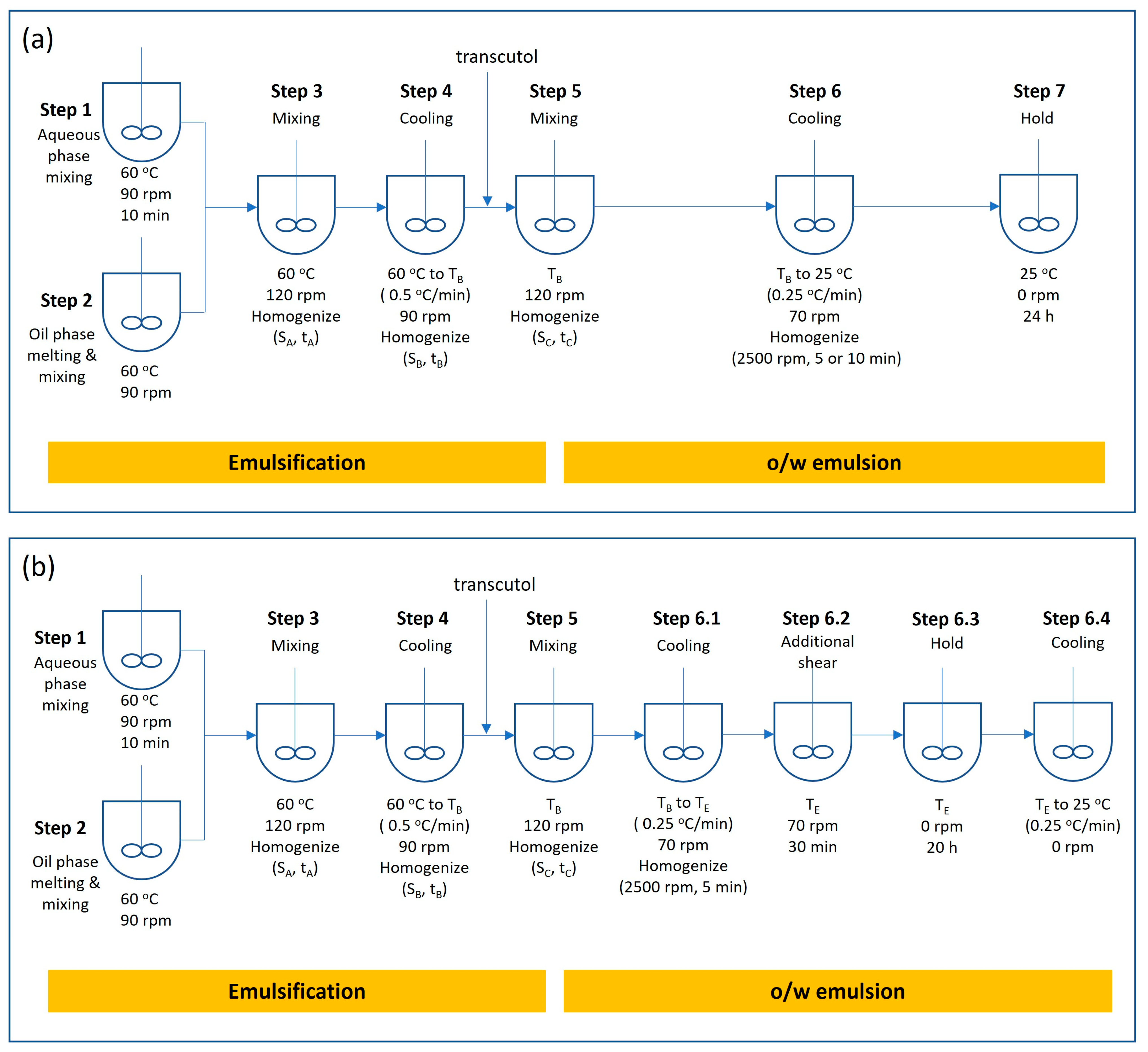
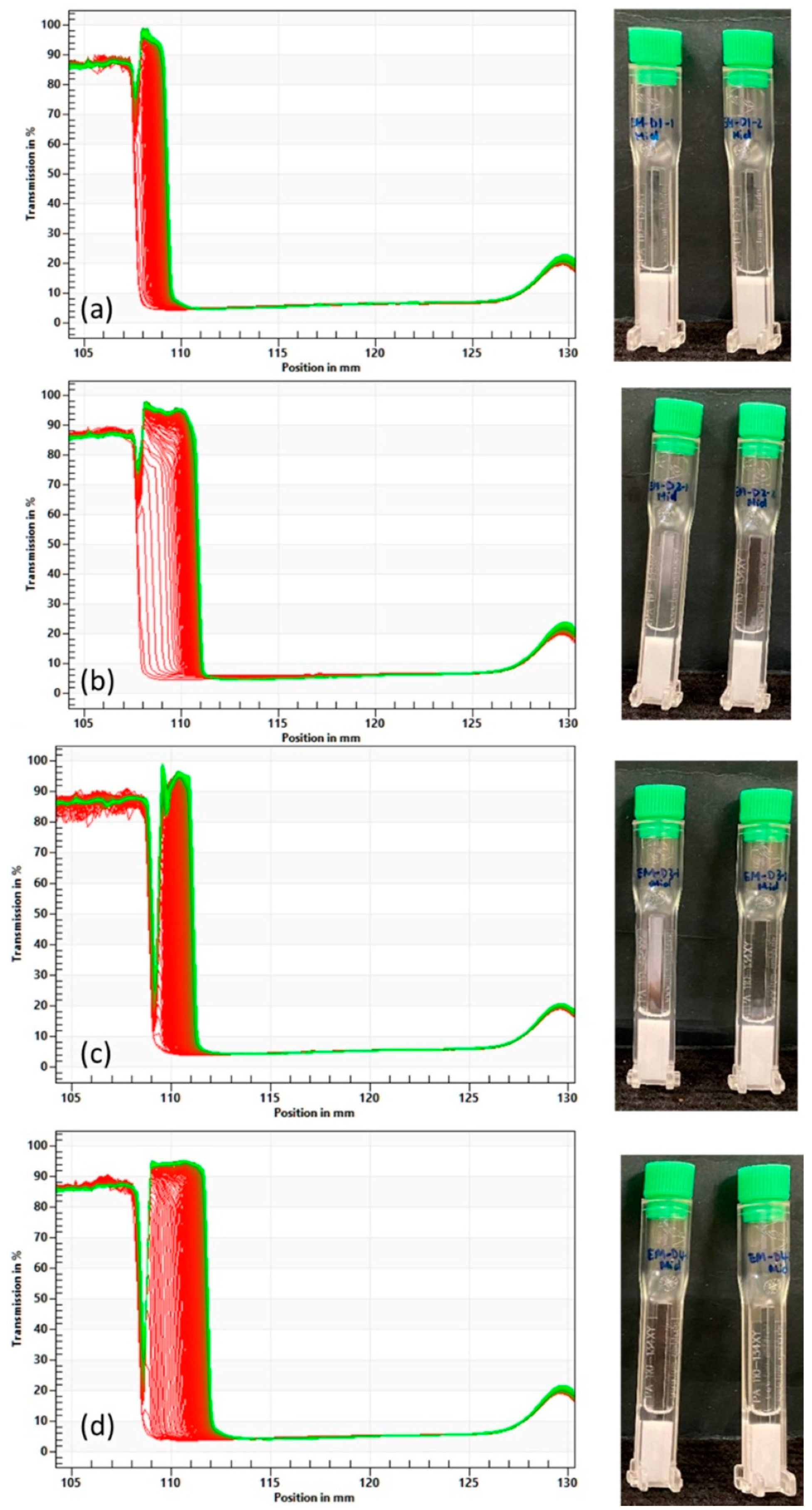
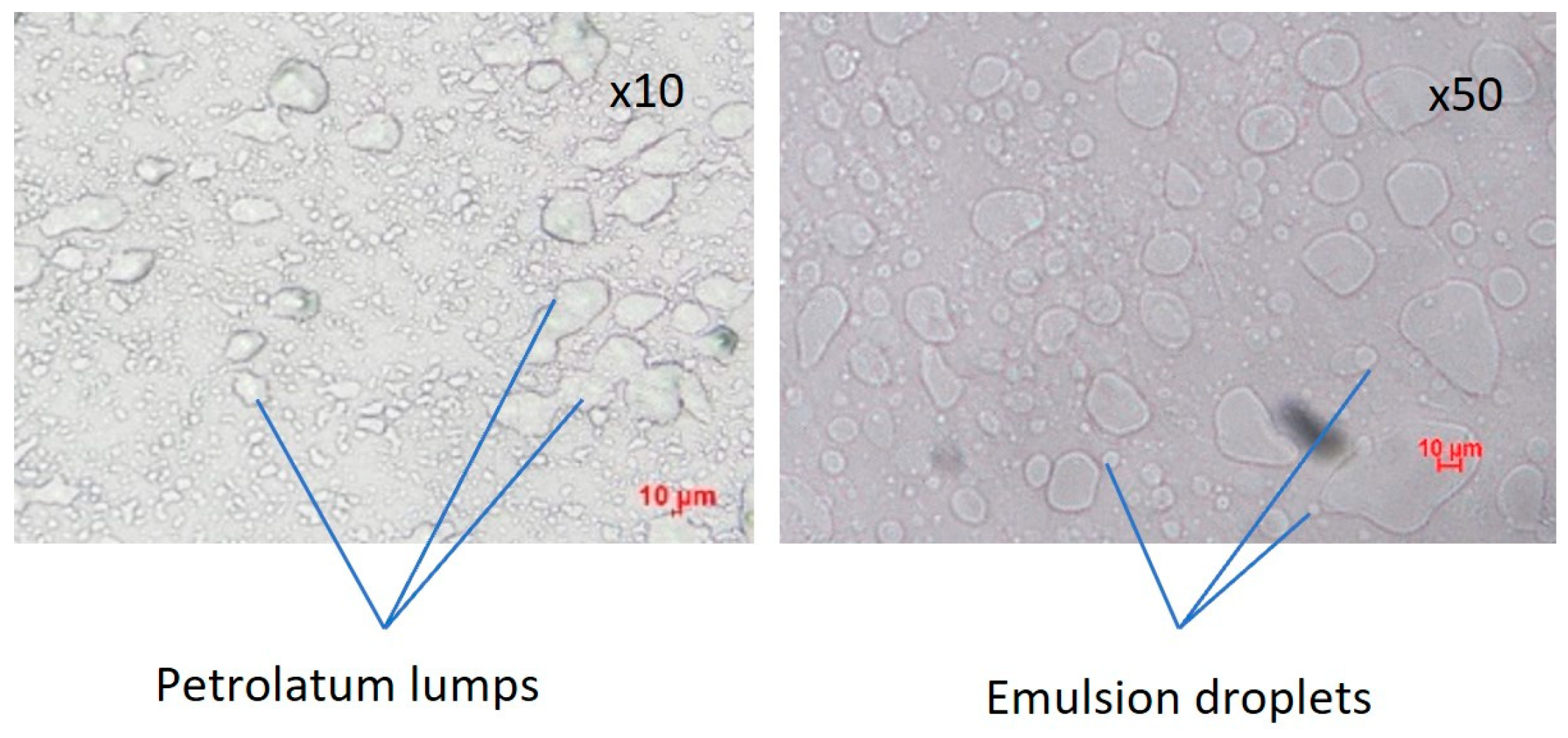
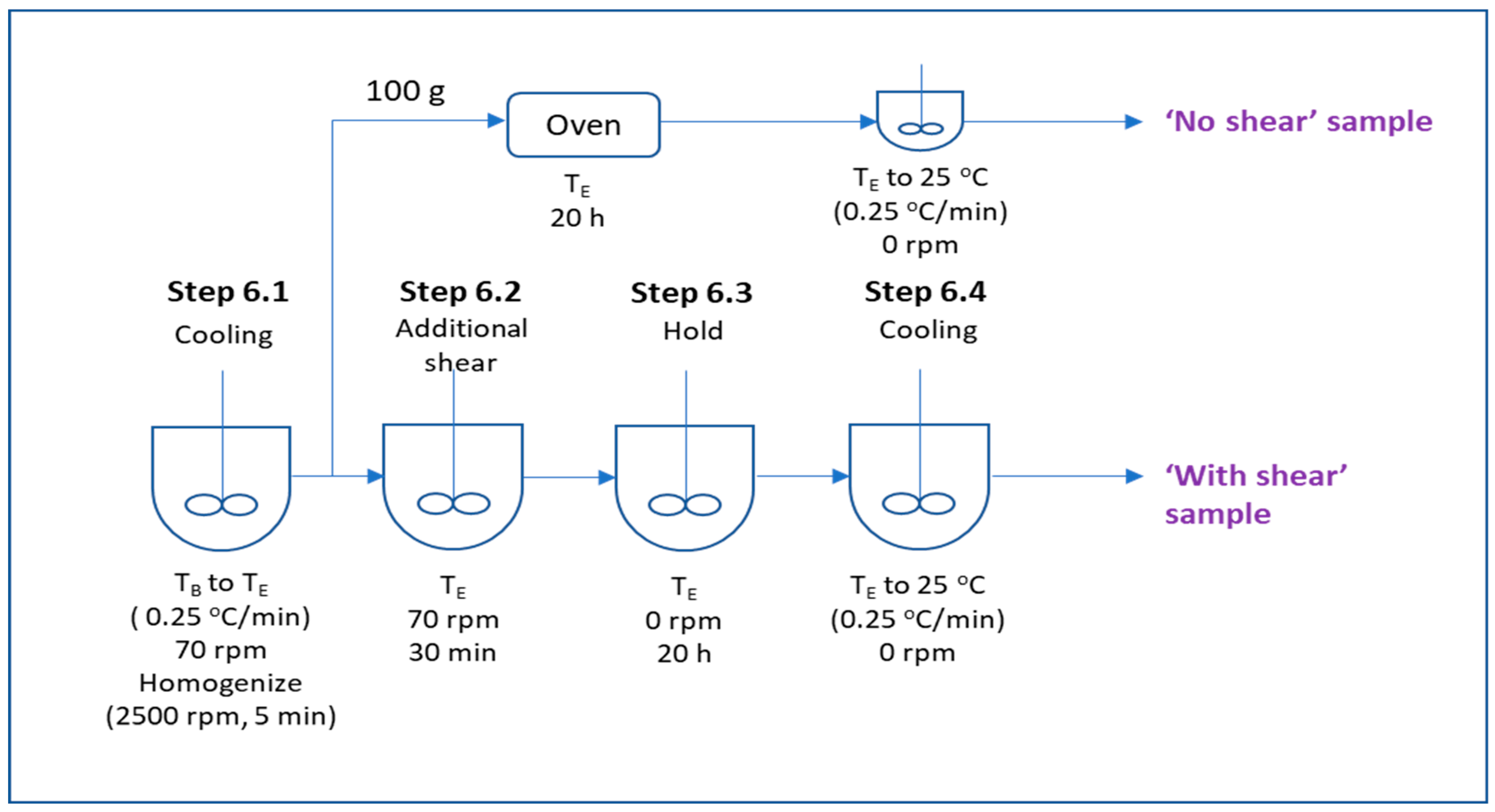
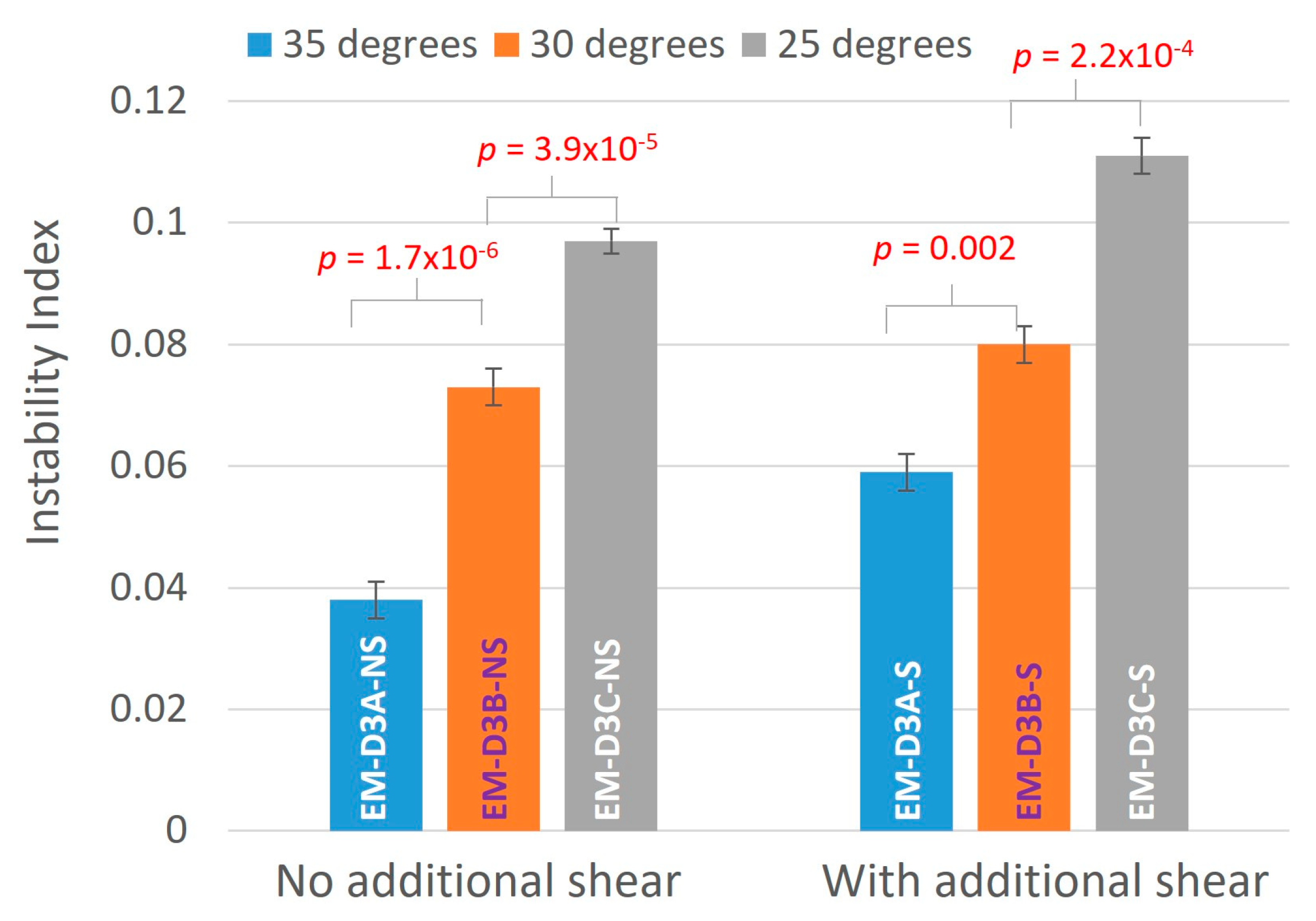



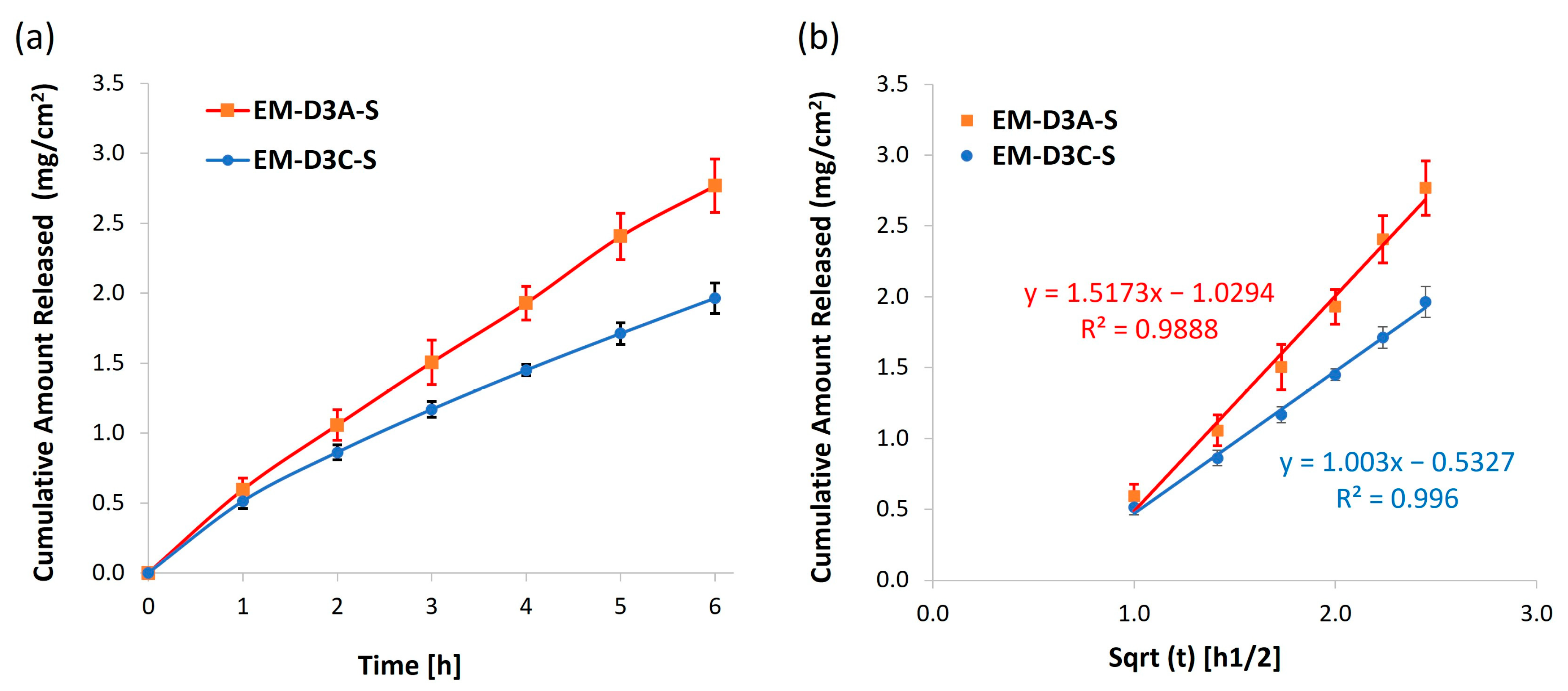
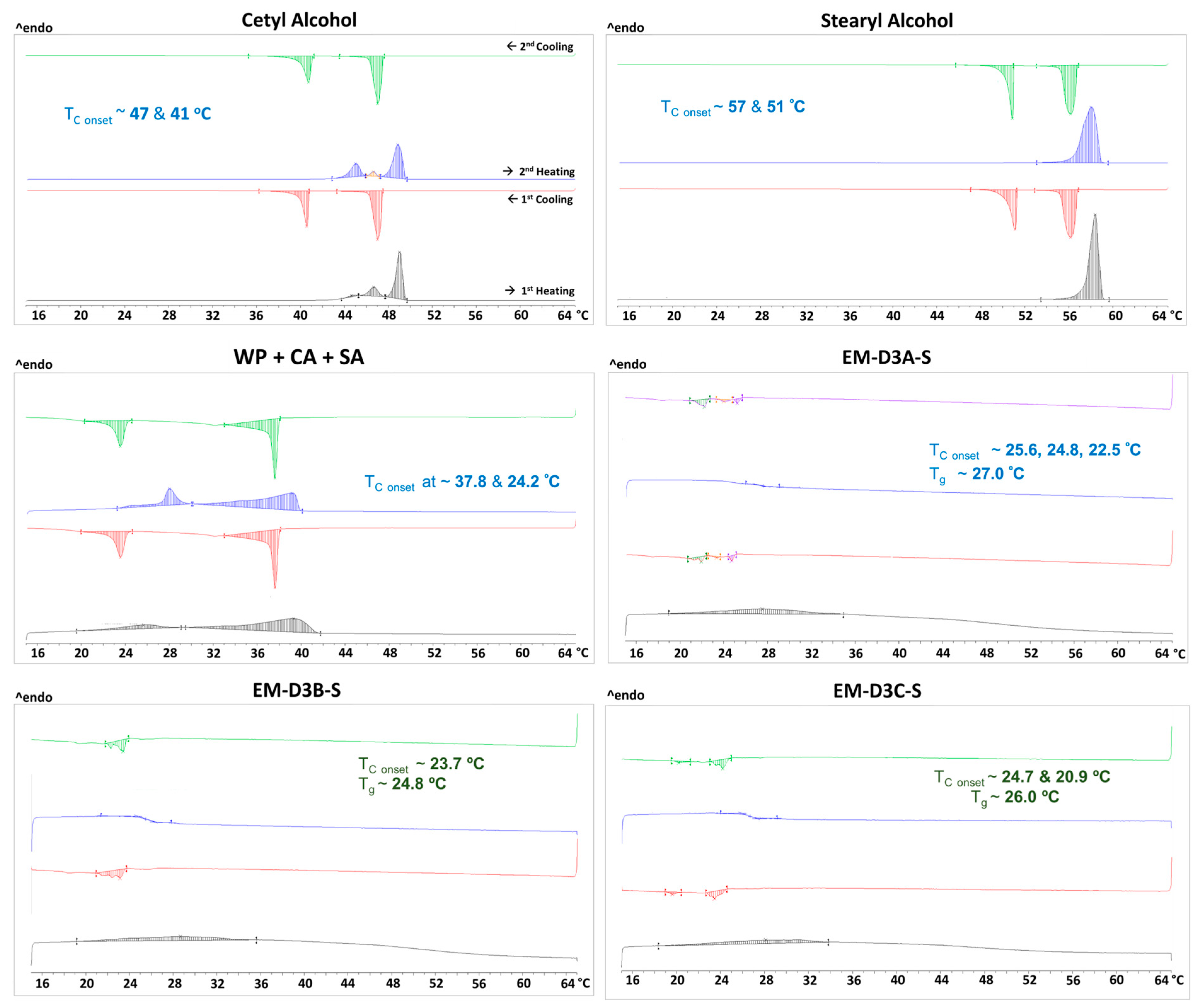
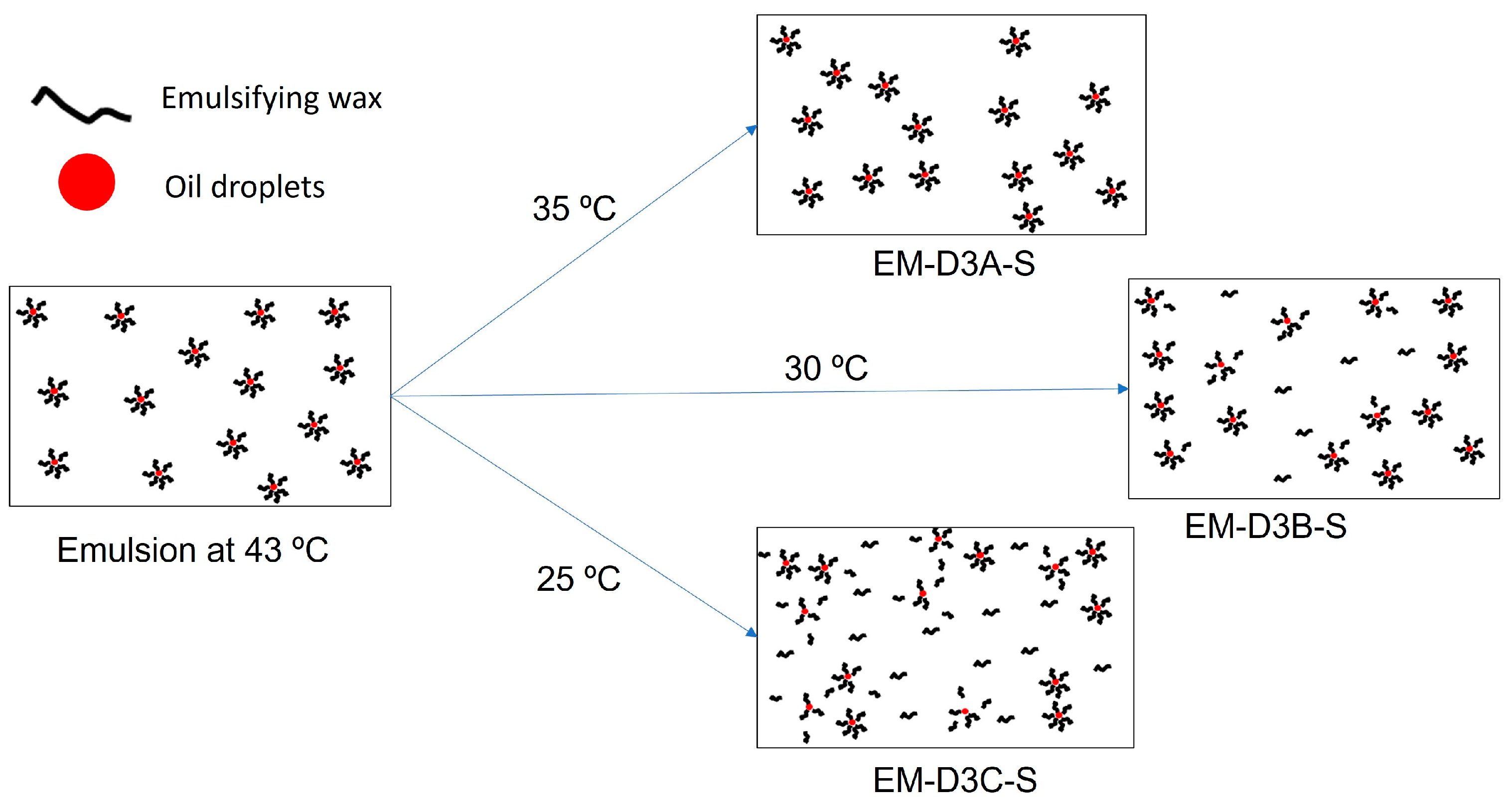
| Ingredient | Phase | Wt.% |
|---|---|---|
| Purified water (q.s.) | Aqueous phase | 38.0–48.0 |
| PEG400 | 15.0 | |
| Light mineral oil | Oil phase | 5.0–10.0 |
| White petrolatum (WP) | 10.0 | |
| Oleyl alcohol | 2.0 | |
| Emulsifying wax (GMS, Tween20, CA, SA) | Emulsifier | 5.0–10.0 |
| Transcutol | Active Solvent | 15.00 |
| Total | 100 |
| Processing Conditions | Levels | |
| [SA] | Step 3 homogenization speed | 2500, 4000, 8000 rpm |
| [tA] | Step 3 homogenization duration | 10, 30 min |
| [TB] | Transcutol addition temperature | 35 ± 3, 43 ± 3 °C |
| [SB] | Step 4 homogenization speed | 2500 rpm |
| [tB] | Step 4 homogenization duration | 5 min (twice, at ~56 °C and 50 °C) or 30 min (once, at 60 °C) |
| [SC] | Step 5 homogenization speed | 2500 rpm |
| [tC] | Step 5 homogenization duration | 15, 30 min |
| [TE] | Additional shearing temperature during the final hold and cooling stage | 35 ± 3, 30 ± 3, 25 ± 3 °C |
| Processing Stages | Conditions | Sample | ||||||||||
|---|---|---|---|---|---|---|---|---|---|---|---|---|
| EM-D1 | EM-D2 | EM-D3 | EM-D4 | EM-D6 | EM-D7 | EM-D8 | EM-D9 | EM-D10 | EM-D11 | EM-D12 | ||
| Step 3 mixing | Homogenization speed [SA] (rpm) | 8000 | 8000 | 8000 | 8000 | 2500 | 4000 | 8000 | 2500 | 4000 | 8000 | 8000 |
| Homogenization duration [tA] (min) | 10 | 10 | 10 | 10 | 10 | 10 | 10 | 10 | 10 | 10 | 10 | |
| Transcutol addition | Temperature [TB] (°C) | 43 | 43 | 43 | 43 | 43 | 43 | 35 | 35 | 35 | 35 | 43 |
| Step 4 cooling from 60 °C to [TB] | Homogenization speed [SB] (rpm) | 2500 | 2500 | 2500 | 2500 | 2500 | 2500 | 2500 | 2500 | 2500 | 2500 | 2500 |
| Step 5 mixing after transcutol addition | Homogenization speed [SC] (rpm) | 2500 | 2500 | 2500 | 2500 | 2500 | 2500 | 2500 | 2500 | 2500 | 2500 | 2500 |
| Composition | Mineral oil (wt%) | 5 | 10 | 5 | 10 | 5 | 5 | 5 | 5 | 5 | 5 | 5 |
| Emulsifying wax (wt%) | 5 | 5 | 10 | 10 | 5 | 5 | 5 | 5 | 5 | 5 | 5 | |
| White Petrolatum (wt%) | 10 | 10 | 10 | 10 | 10 | 10 | 10 | 10 | 10 | 20 | 20 | |
| Microscopy measurement | Droplet size (µm) | 7.70 ± 9.35 | N.M. | 6.92 ± 6.15 | N.M. | 7.86 ± 8.53 | 6.63 ± 6.58 | 6.60 ± 8.22 | 7.53 ± 7.55 | 7.03 ± 7.62 | 8.24 ± 10.67 | 7.36 ± 11.31 |
| Stability | Bottle test @40 °C/75%RH (1 Day) | PS | PS | No PS | PS | PS | PS | PS | PS | PS | PS | PS |
| Instability Index (IS) | 0.090 ± 0.005 | 0.151 ± 0.005 | 0.101 ± 0.004 | 0.166 ± 0.001 | 0.112 ± 0.001 | 0.100 ± 0.002 | 0.096 ± 0.004 | 0.101 ± 0.004 | 0.102 ± 0.002 | 0.134 ± 0.001 | 0.142 ± 0.002 | |
| Complex Shear Modulus (G*) (Pa) | 688 ± 30 | 606 ± 2.7 | 1867 ± 93 | 1607 ± 43 | 823 ± 47 | 696 ± 16 | 698 ± 23 | 600 ± 42 | 557 ± 21 | 1178 ± 235 | 1063 ± 93 | |
| Crossover Stress (σcross) (Pa) | 15.0 ± 1.1 | 8.80 ± 1.3 | 24.4 ± 0.9 | 18.4 ± 0.5 | 11.9 ± 0.2 | 13.5 ± 0.3 | 15.3 ± 0.2 | 13.5 ± 1.4 | 14.0 ± 0.4 | 16.1 ± 1.5 | 13.7 ± 2.2 | |
| Processing Stages | Conditions | Sample | |||
|---|---|---|---|---|---|
| EM-D13 | EM-D3 | EM-D3N1 | EM-D3N2 | ||
| Step 3 mixing | Homogenization speed [SA] (rpm) | 2500 | 8000 | 8000 | 2500 |
| Homogenization duration [tA] (min) | 10 | 10 | 30 | 30 | |
| Transcutol addition | Temperature [TB] (°C) | 43 | 43 | 43 | 43 |
| Step 4 cooling from 60 °C to [TB] | Homogenization speed [SB] (rpm) | 2500 | 2500 | 2500 | 2500 |
| Homogenization Duration [tB] (min) | 10 | 10 | 30 | 30 | |
| Step 5 mixing after transcutol addition | Homogenization speed [SC] (rpm) | 2500 | 2500 | 2500 | 2500 |
| Homogenization duration [tC](min) | 15 | 15 | 30 | 30 | |
| Composition | Mineral Oil Content (wt%) | 5 | 5 | 5 | 5 |
| Emulsifier Content (wt%) | 10 | 10 | 10 | 10 | |
| White Petrolatum (wt%) | 10 | 10 | 10 | 10 | |
| Stability | Bottle test @40 °C/75%RH (1-Day) | No PS | No PS | No PS | No PS |
| Instability Index (IS) | 0.101 ± 0.002 | 0.101 ± 0.004 | 0.106 ± 0.001 | 0.110 ± 0.001 | |
| Complex Shear Modulus (G*) (Pa) | 1831 ± 112 | 1867 ± 93 | 1982 ± 122 | 1814 ± 16 | |
| Crossover Stress (σcross) (Pa) | 23.7 ± 2.6 | 24.4 ± 0.9 | 25.4 ± 2.3 | 23.6 ± 0.2 | |
| Processing Stages | Conditions | Run Number/Sample | ||||||||||||
|---|---|---|---|---|---|---|---|---|---|---|---|---|---|---|
| Run 1 | Run 2 | Run 3 | Run 4 | Run 5 | Run 6 | Run 7 | Run 8 | Run 9 | Run 10 | Run 11 | Run 12 | Run 13 | ||
| EM-D3 | EM-D3A-NS | EM-D3A1-NS | EM-D3A-S | EM-D3A1-S | EM-D3B-NS | EM-D3B1-NS | EM-D3B-S | EM-D3B1-S | EM-D3C-NS | EM-D3C1-NS | EM-D3C-S | EM-D3C1-S | ||
| Step 3 mixing | [SA] (rpm) | 8000 | 8000 | 2500 | 8000 | 2500 | 8000 | 2500 | 8000 | 2500 | 8000 | 2500 | 8000 | 2500 |
| [tA] (min) | 10 | 10 | 10 | 10 | 10 | 10 | 10 | 10 | 10 | 10 | 10 | 10 | 10 | |
| Transcutol addition | [TB] (°C) | 43 | 43 | 43 | 43 | 43 | 43 | 43 | 43 | 43 | 43 | 43 | 43 | 43 |
| Step 4 cooling | [SB] (rpm) | 2500 | 2500 | 2500 | 2500 | 2500 | 2500 | 2500 | 2500 | 2500 | 2500 | 2500 | 2500 | 2500 |
| [tB] (min) | 10 | 10 | 10 | 10 | 10 | 10 | 10 | 10 | 10 | 10 | 10 | 10 | 10 | |
| Step 5 mixing | [SC] (rpm) | 2500 | 2500 | 2500 | 2500 | 2500 | 2500 | 2500 | 2500 | 2500 | 2500 | 2500 | 2500 | 2500 |
| [tC] (min) | 15 | 15 | 15 | 15 | 15 | 15 | 15 | 15 | 15 | 15 | 15 | 15 | 15 | |
| Holding temperature | [TE] (°C) | - | 35 | 35 | 35 | 35 | 30 | 30 | 30 | 30 | 25 | 25 | 25 | 25 |
| Additional shear | Mixing speed (rpm) | - | - | - | 70 | 70 | - | - | 70 | 70 | - | - | 70 | 70 |
| Duration (min) | - | - | - | 30 | 30 | - | - | 30 | 30 | - | - | 30 | 30 | |
| Stability | Bottle test @40 °C/75%RH (1-Day) | No PS | No PS | No PS | No PS | No PS | No PS | No PS | No PS | No PS | No PS | No PS | No PS | No PS |
| Instability Index (IS) | 0.101 ± 0.004 | 0.038 ± 0.003 | 0.051 ± 0.003 | 0.059 ± 0.003 | 0.071 ± 0.001 | 0.073 ± 0.003 | 0.084 ± 0.007 | 0.080 ± 0.003 | 0.092 ± 0.005 | 0.097 ± 0.002 | 0.103 ± 0.008 | 0.111 ± 0.003 | 0.114 ± 0.003 | |
| Complex Shear Modulus (G*) (Pa) | 1867 ± 93 | 2598 ± 149 | 3210 ± 146 | 3308 ± 156 | 2878 ± 51 | 2811 ± 14 | 3378 ± 127 | 2677 ± 103 | 2831 ± 161 | 2167 ± 99 | 2412 ± 42 | 1549 ± 44 | 1863 ± 42 | |
| Crossover Stress (σcross) (Pa) | 24.4 ± 0.9 | 52.5 ± 1.9 | 50.0 ± 0.9 | 47.1 ± 2.1 | 51.3 ± 2.0 | 36.8 ± 0.8 | 31.6 ± 0.7 | 37.6 ± 1.2 | 28.7 ± 1.3 | 23.1 ± 0.1 | 28.3 ± 0.4 | 21.8 ± 0.6 | 24.6 ± 1.6 | |
Disclaimer/Publisher’s Note: The statements, opinions and data contained in all publications are solely those of the individual author(s) and contributor(s) and not of MDPI and/or the editor(s). MDPI and/or the editor(s) disclaim responsibility for any injury to people or property resulting from any ideas, methods, instructions or products referred to in the content. |
© 2024 by the authors. Licensee MDPI, Basel, Switzerland. This article is an open access article distributed under the terms and conditions of the Creative Commons Attribution (CC BY) license (https://creativecommons.org/licenses/by/4.0/).
Share and Cite
Chow, P.S.; Lim, R.T.Y.; Cyriac, F.; Shah, J.C.; Badruddoza, A.Z.M.; Yeoh, T.; Yagnik, C.K.; Tee, X.Y.; Wong, A.B.H.; Chia, V.D.; et al. The Effect of Process Parameters on the Microstructure, Stability, and Sensorial Properties of an Emulsion Cream Formulation. Pharmaceutics 2024, 16, 773. https://doi.org/10.3390/pharmaceutics16060773
Chow PS, Lim RTY, Cyriac F, Shah JC, Badruddoza AZM, Yeoh T, Yagnik CK, Tee XY, Wong ABH, Chia VD, et al. The Effect of Process Parameters on the Microstructure, Stability, and Sensorial Properties of an Emulsion Cream Formulation. Pharmaceutics. 2024; 16(6):773. https://doi.org/10.3390/pharmaceutics16060773
Chicago/Turabian StyleChow, Pui Shan, Ron Tau Yee Lim, Febin Cyriac, Jaymin C. Shah, Abu Zayed Md Badruddoza, Thean Yeoh, Chetan Kantilal Yagnik, Xin Yi Tee, Annie Bao Hua Wong, Vernissa Dilys Chia, and et al. 2024. "The Effect of Process Parameters on the Microstructure, Stability, and Sensorial Properties of an Emulsion Cream Formulation" Pharmaceutics 16, no. 6: 773. https://doi.org/10.3390/pharmaceutics16060773







